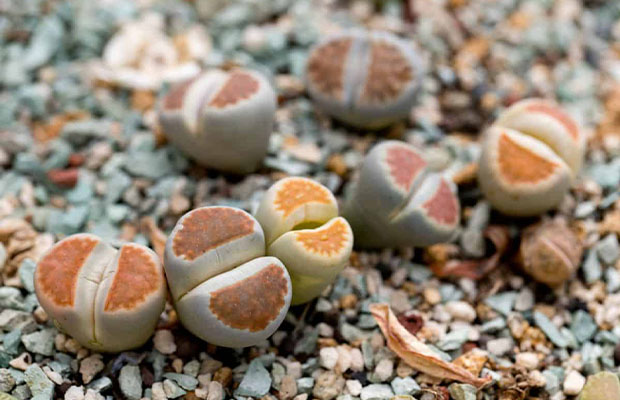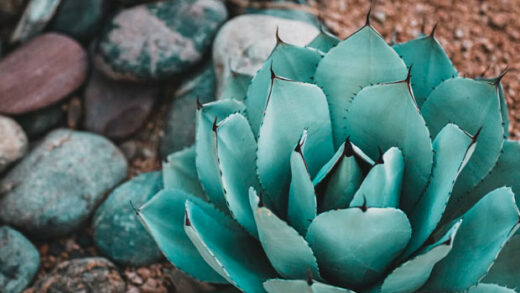Have you ever been browsing a garden center’s succulent section when you came across a pot that contained nothing more than a pair of flat-topped split rocks? If so, you might have come across the unusual succulent genus known as lithops, which is found in Africa.
Lithops are one of the most unique succulent plants you can grow. Also called living stone succulent, their crazy-cool appearance makes them both a curiosity and a prized treasure for houseplant enthusiasts.
we will cover how to grow and care for living stone succulents and all key information, keep reading!
Table of Contents
What is a Lithops Plant?
Lithops are succulents in the family Aizoaceae. These little charmers are in the genus Lithops, and they are native to Namibia and South Africa. They do resemble stones in appearance. Their natural habitat is dry, rocky terrain, which is why they have developed such an ingenious camouflage to shield themselves from herbivorous predators that are on the prowl.
A fissure separates each of the leaves on a lithops plant, which have a pair of leaves that resemble rubbery pads more than actual leaves. Each season, a fresh pair of leaves emerges from the fissure, frequently in the spring when the old leaves split open to reveal the emergence of the new leaves. Old leaves shrivel and die as a result of this. Lithops have a single, lengthy taproot that has tiny root hairs sticking out of it.
The middle fissure in the tree produces a single flower in the autumn. The flowers can be white or yellow and occasionally have a delectable scent. The daisy-like flowers have a diameter of about a half-inch. They open in the late afternoon and close in the evening.
Related Reading:
Types of Living Stone Succulent
Lithops come in a variety of forms and have the ability to establish sizable colonies in their natural habitat. There are numerous species, along with numerous subspecies and varieties. Although not all varieties of living stones are offered in the plant trade, those who are interested in growing living stones can choose from a wide range of hues and varieties. Collecting plants of every hue and growing them separately or in groups to create vibrant color combinations is enjoyable.
Popular lithops species include lesliei, marmorata, hookeri, helmutii, bromfieldii, and terricolor, among many others.
Each species’ and variety’s markings and leaf color are a result of the environment it evolved in or, if a cross-pollinated variety, the breeding process (more on this in a moment). From muted gray, green, yellow, and brown to pink, cream, and orange, lithops come in an odd assortment of hues and patterns. Some species are even more collectible because they also have lines and/or dots on them.

How to Grow Living Stones from Seed?
In the fall, your living stones will bloom with flowers that eventually turn into seed pods that can be harvested to sprout new plants. Here’s how:
- Search your living stone for the seed pod. Trim the pod from the plant with a tidy pair of gardening shears.
- Use a dropper to add a few drops of water to the pod’s exterior or immerse it in water. The pod will start to open. (Rain opens the seed pod in its natural environment.)
- To gently remove the seeds from inside the pod after it has been cracked open, use a toothpick or a pair of tweezers.
- Using a mix of well-draining cactus soil, prepare a fresh pot. Apply water to moisten the soil.
- Spread the seeds from your living stones over the soil’s surface, then sprinkle a thin layer of sand over them.
- Simply enough to keep the sand moist but not soggy, water the container as needed. When the seeds sprout, start watering them less frequently and take care of the plants as usual.
Living Stone Succulent Care
Living stones make fascinating plants to grow because of their distinctive appearance. They require incredibly little upkeep as plants. However, in order for plant owners to maintain their health, they must satisfy certain environmental needs.
These plants require as much light as they can get. If you’re growing living stones indoors and don’t have a bright window, you might need to spend money on an artificial grow light for them. Additionally, the most important aspect of caring for this species is typically providing proper watering. Living stones can withstand drought very well, but too much water can quickly kill them, especially if it encourages root rot or fungal growth. Living stones, fortunately, don’t typically contract many diseases, so if you mainly leave them alone, they should thrive. In fact, you probably won’t need to do anything other than check on them to make sure they’re healthy for about half of the year.
Light
All year long, living stones prefer full sun, which is defined as at least six hours of sunlight per day. Place these succulents by your brightest window (south exposure is best) if you’re growing them indoors. Longer leaves and unattractive leaf coloring are two effects of inadequate lighting.
Soil
Sandy soil with good drainage is preferred by these plants. For living stones, cactus-specific potting soil works best, and the container needs to have several drainage holes on the bottom.
Water
Living stones must receive water on a seasonal schedule that reflects the amount of rainfall they would experience in their natural environment. During the summer and winter, when the plant is dormant, avoid watering. Then soak the soil, letting it completely dry out before watering it once more (this should take about 1-2 weeks). When the soil dries out in the spring after the new leaves have started to emerge, water it just enough to moisten it. During the plant’s second dormant season in the summer, halt watering once more. Early in the fall, just before the plant is prepared to bloom, start watering again. You can give the plant a very small amount of water to plump the leaves back up if they begin to completely shrivel up while it is dormant.
Related Reading: How Often To Water Succulents?
Temperature and Humidity
Living stones can endure temperatures as low as 50 degrees Fahrenheit and can tolerate heat well. In a typical room between 65 and 80 degrees, they thrive. As long as the soil doesn’t stay wet for extended periods of time and there is good airflow around the plants, humidity typically isn’t a problem.
Fertilizer
Although these plants don’t require much food and typically grow in poor soil, a fertilizer with a low nitrogen and high potassium content can help promote flowering.
Repotting Lithops
These little cuties won’t require many repots. You can typically keep your lithops in the same pot for many years because they are such small plants. You won’t need to repot until after dividing any pups (see the Propagating Lithops section below). You will eventually need to transfer the group of plants into a slightly larger pot, again using only good draining soil, if you don’t separate the plants and your colony becomes large. Due to their long taproots, lithops should be planted in pots that are at least 4 inches deep. Plants should be tucked into the ground so that only the top edge is visible. A decorative display is produced by placing colorful aquarium gravel or naturally colored gravel on top of the pot.
Propagation Techniques
An enjoyable project is to create more living stones to add to your collection or share with friends. This plant can be multiplied in two different ways.
Common Problems With Living Stones
Generally speaking, living stones are simple to maintain, but they can occasionally experience some growth issues. The most frequent causes of this are inadequate light or water, both of which can be changed to maintain the health of your plants.
Discolored Leaves
When they don’t get enough sunlight, your living stones might start to fade in color. The leaves may also lengthen as the plant reaches for the sun as a result of insufficient lighting. In either of these scenarios, relocate your living stones to a location with direct sunlight to assist in the problem-solving process.
Shriveled Or Wrinkled Leaves
Although they can get shriveled or wrinkled leaves in the spring and fall if they’re too dry while actively growing, living stones don’t typically have problems with too little water. Just enough water should be added so that the soil around your plant is barely damp. To avoid drowning the plant, misting the soil rather than the leaves can be helpful.
Mushy Leaves
It’s probably getting too much water if your plant’s leaves feel excessively mushy or soft to the touch. Overwatering can cause root rot, which attracts pests more than living stones. When your plant is dormant, never water it. In the spring and fall, make sure the soil is moist to the touch but never soggy.
Also Read: Why is My Succulent Dying?
Lithops Succulent Adaptations
Lithops can thrive in harsh environments with little water and food. The plant has little foliar space to absorb solar energy because the majority of its body is underground. As a result, the plant has developed a unique way of enhancing solar collection by means of “windowpanes” on the surface of the leaf. The calcium oxalate that fills these translucent regions produces a reflective facet that improves light transmission. The long lifespan of the seed capsules is another fascinating adaptation of lithops. In their natural environment, where moisture is scarce, seeds can survive for months in the soil.
FAQs
Do Living Stones Multiply?
Living stones naturally multiply by growing new plants on their own in the same container. This species can be manually multiplied by division once several plants have begun to grow together in order to keep them from engulfing the pot. In the spring, when the plants are actively growing, this procedure should be finished.
Do Living Stones Need Light?
Living stones prefer plentiful sunlight, all year long. Many succulent growers fail to provide their plants with the necessary light. This plant must be placed in a window where it will get at least six hours of sunlight each day.
How Do You Keep Living Stones Alive?
Living stones are exceptionally simple plants to maintain, necessitating little in the way of watering or other care throughout most of the year. Put your plant in full sun, and during the spring and fall, only lightly water the soil when it becomes dry (do not water in the summer or winter).
How Long Do Living Stones Live?
If given the right care and growing conditions, living stones have a very long lifespan and can last up to 50 years.
Do Living Stones Multiply?
By dispersing seeds from the pods that are left behind after their flowers wilt, living stones reproduce on their own. If the original pot gets too full, gardeners can divide the new plants and move them to different pots.
Takeaway
As long as you remember what type of climate the plant is native to and replicate those growing conditions, lithops are simple to take care of. AD When growing living stones, take great care not to overwater.
During their dormant season, which lasts from fall to spring, these tiny succulent plants don’t need to be watered. When you start watering again in the spring, add a diluted cactus fertilizer if you want to promote flowering. If you want to learn more about succulents, read our post on how to plant succulents.

















